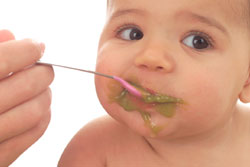Choice is a great thing, but it has its downsides as well. Dr Joe Kosterich talks about fussy eating in children, including what causes it, how to deal with it, and why it’s important to make sure your child eats a variety of foods.
Video transcript
 Even two generations back, children needed to eat what was on their plate or they may get sent to bed without any supper – it wasn’t an optional thing. Going further back in human history, often people (adults as well as children) were happy just to have some food on their plate at all; and, of course, there was a time when food didn’t come on plates.
Even two generations back, children needed to eat what was on their plate or they may get sent to bed without any supper – it wasn’t an optional thing. Going further back in human history, often people (adults as well as children) were happy just to have some food on their plate at all; and, of course, there was a time when food didn’t come on plates.
So the notion of ‘fussy eating’ is a relatively new phenomenon, and it really can only apply in circumstances where there is enough food to eat and enough choice that people can express a preference for one type of food over another.
In a practical sense, what do parents do with fussy eaters? First of all, let’s think about terminology: what does it actually mean? It may mean different things to different people. ‘Fussy’ implies I’m going to eat one sort of food but not another type. We all have likes and dislikes, and these obviously start at a young age. So some people will prefer (and this also applies to children) apples; some might prefer pears. It’s not right or wrong. However, for children to grow and develop, they do need a balance of all sorts of foods and nutrients.
A child can actually only eat what the parent offers it. One of the things I hear sometimes in the surgery is, “My child won’t get off formula.” And the discussion goes, “I tried to get them to eat something, the child won’t eat anything, so I end up giving them a bottle.” Okay, that’s fine, but it’s a clash of wills. If the child wins, then the child will continue to want what he wants. So rule number one – and it’s almost like a golden rule – is that as a parent, you are in charge. There is no child who has ever successfully gone on a hunger strike and starved themselves to death; it just will not happen. Intuition kicks in; survival instinct kicks in. That is a fear of parents, but it’s an ungrounded fear.
Offer different foods. Be prepared to experiment, but don’t back down. If you’re wanting to – and this is particularly for children as you’re introducing solids and more foods as they go to the ages of 1, 2 and 3 – put things on the plate. Don’t offer alternatives. This is what’s being offered now and today; this is what you’re going to eat. If you don’t like it, then fine, wait for the next meal. If the children are hungry, they will eat it. If they aren’t, they won’t.
You don’t have to be that rigid if you don’t want to. You may put a few different things on the plate, and that’s fine. But children do need to develop a taste for different foods, and that’s particularly fruits and vegetables. It has been shown that introducing these foods at a younger age helps with diet later in life. So if you only offer milk or you only offer sweet-type foods, the child’s palate will develop that way and that’s what they will want – and it’s hardly a surprise.
To sum up, fussy eating is something that can be managed and controlled, but the essential and critical point to it is that what a child eats is a function of what you as a parent offer them. Offer a variety of foods and be prepared to hold the line, and you will find that your child will develop a balanced palate and diet.
(Source: myVMC)



 (6 votes, average: 4.00 out of 5)
(6 votes, average: 4.00 out of 5) 






